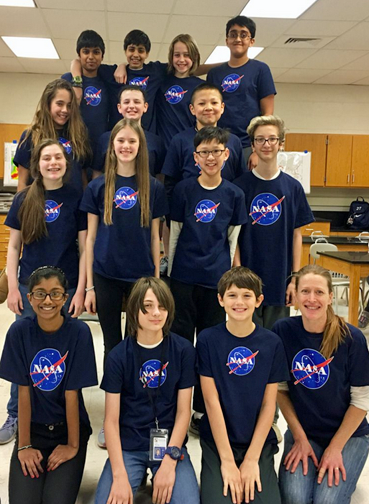
The Timberlane Middle School NASA SLED team: (kneeling) Melissa Isaac, Aidan Norton, Charlie Stowe, Kimberly Renick; (2nd row) Erin Goldsmith, Kate Crotty, James Lee, Konrad DeMartino; (3rd row) Taylor Foret, Abby Prosser, David Gao; (top row) Sathya Kummarapurugu, Karthik Appana, Bryce Ansari and Dhanvi Ganti.
From MERCERSPACE online infosite, and reported by Michele Alperin, a news story features Kimberly Renick who, in her first year as a sixth-grade science teacher at Timberlane Middle School in Hopewell, will soon be traveling to NASA’s Johnson Space Center in Houston to test her students’ prototype of a satellite launcher, whose design proposal was one of 16 top-rated proposals in a NASA challenge.
The students’ accomplishment in designing and creating the prototype confirmed Renick’s belief in the value of hands-on learning. “I wanted something for my students that would bring in the real world—that they would understand they are learning for a reason,” she said.
The project has real-world grounding: NASA ran into trouble with the automatic deployment system used by the International Space Station, when it failed to release satellites when commanded, and inadvertently or prematurely released satellites. NASA challenged teams of educators and their students to help it improve its system by designing a prototype that would then be tested on a special floor that simulates what is called “microgravity” in space. The teams will also investigate whether a manual launcher with a human interface or one that is automatically controlled works best.
For this project, Renick needed to consult with a team of five teachers before submitting an application to NASA. She reached out to some she had met at a NASA course on meteorites and asteroids at the Goddard Space Flight Center in Greenbelt, Maryland. She told the teachers that the students had to design a prototype, and the teachers had to submit an extensive application with goals and lesson plans in two weeks. They made the deadline, and the application was accepted.
Renick exposed her students to a basic understanding of the physics the project would involve, asking the students if they thought a manual or an automatic launcher was better. Some students argued that “humans can make adjustments. If something goes wrong at the end, we can take it into account and make changes.” Others raised a counterargument, “Let’s think of football. A quarterback, no matter how good, can’t throw a football in the same spot at the same rate every time.”
She also asked her students to research launching devices, both historical and current, like pitching machines, skeet shooters, and catapults, to learn how they worked. Seventy-five Timberlane students came up with concepts for an automatic launching device. Renick narrowed the students’ designs to 15. Those 15 were submitted by Bryce Ansari, Karthik Appana, Dhanvi Ganti, David Gao, James Lee, Konrad DeMartino, Abby Prosser, Melissa Isaac, Taylor Foret, Aidan Norton, Charlie Stowe, Sathya Kammaraporugu, Erin Goldsmith, Kate Crotty and Caileigh Ross.
To read the remainder of the story, please access mercerspace.com/2017/03/28/hopewell-6th-grade-team-excels-in-nasa-satellite-launcher-challenge/

